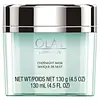Cetaphil Daily Defence Face Moisturiser With SPF 50+ Versus Olay Regenerist Luminous Overnight Gel Mask
What's inside
What's inside
 Key Ingredients
Key Ingredients

 Benefits
Benefits

 Concerns
Concerns

 Ingredients Side-by-side
Ingredients Side-by-side

Water
Skin ConditioningC12-15 Alkyl Benzoate
AntimicrobialGlycerin
HumectantEthylhexyl Salicylate
UV AbsorberTitanium Dioxide
Cosmetic ColorantButyl Methoxydibenzoylmethane
UV AbsorberPropylene Glycol
HumectantBis-Ethylhexyloxyphenol Methoxyphenyl Triazine
Skin ConditioningOctocrylene
UV AbsorberCyclopentasiloxane
EmollientStearic Acid
CleansingDimethicone
EmollientMethyl Methacrylate Crosspolymer
Nylon-12
Petrolatum
EmollientAluminum Hydroxide
EmollientAmmonium Polyacryloyldimethyl Taurate
Emulsion StabilisingDisodium EDTA
Drometrizole Trisiloxane
UV AbsorberEthylhexyl Triazone
UV AbsorberEthylparaben
PreservativeGlyceryl Stearate
EmollientHydrogenated Soybean Oil
EmollientHydroxypropyl Methylcellulose
Emulsion StabilisingMethylparaben
PreservativeMyristyl Myristate
EmollientPEG-100 Stearate
Phenoxyethanol
PreservativePotassium Cetyl Phosphate
EmulsifyingPropylparaben
PreservativeSodium Chloride
MaskingStearyl Alcohol
EmollientTerephthalylidene Dicamphor Sulfonic Acid
UV AbsorberTocopherol
AntioxidantTriethanolamine
BufferingWater, C12-15 Alkyl Benzoate, Glycerin, Ethylhexyl Salicylate, Titanium Dioxide, Butyl Methoxydibenzoylmethane, Propylene Glycol, Bis-Ethylhexyloxyphenol Methoxyphenyl Triazine, Octocrylene, Cyclopentasiloxane, Stearic Acid, Dimethicone, Methyl Methacrylate Crosspolymer, Nylon-12, Petrolatum, Aluminum Hydroxide, Ammonium Polyacryloyldimethyl Taurate, Disodium EDTA, Drometrizole Trisiloxane, Ethylhexyl Triazone, Ethylparaben, Glyceryl Stearate, Hydrogenated Soybean Oil, Hydroxypropyl Methylcellulose, Methylparaben, Myristyl Myristate, PEG-100 Stearate, Phenoxyethanol, Potassium Cetyl Phosphate, Propylparaben, Sodium Chloride, Stearyl Alcohol, Terephthalylidene Dicamphor Sulfonic Acid, Tocopherol, Triethanolamine
Water
Skin ConditioningButylene Glycol
HumectantGlycerin
HumectantNiacinamide
SmoothingCyclopentasiloxane
EmollientIsopropyl Isostearate
EmollientDimethicone
EmollientPolymethylsilsesquioxane
Morus Alba Root Extract
BleachingLilium Candidum Flower Extract
Skin ConditioningLonicera Japonica Flower Extract
Skin ConditioningSodium Ascorbyl Phosphate
AntioxidantTocopheryl Acetate
AntioxidantGlucosyl Hesperidin
HumectantPanthenol
Skin ConditioningAcrylates/C10-30 Alkyl Acrylate Crosspolymer
Emulsion StabilisingDimethiconol
EmollientDimethicone Crosspolymer
Emulsion StabilisingAminomethyl Propanol
BufferingPhenoxyethanol
PreservativeDMDM Hydantoin
PreservativeEthylhexyl Salicylate
UV AbsorberBenzyl Alcohol
PerfumingCetyl Alcohol
EmollientIodopropynyl Butylcarbamate
PreservativeDisodium EDTA
Parfum
MaskingWater, Butylene Glycol, Glycerin, Niacinamide, Cyclopentasiloxane, Isopropyl Isostearate, Dimethicone, Polymethylsilsesquioxane, Morus Alba Root Extract, Lilium Candidum Flower Extract, Lonicera Japonica Flower Extract, Sodium Ascorbyl Phosphate, Tocopheryl Acetate, Glucosyl Hesperidin, Panthenol, Acrylates/C10-30 Alkyl Acrylate Crosspolymer, Dimethiconol, Dimethicone Crosspolymer, Aminomethyl Propanol, Phenoxyethanol, DMDM Hydantoin, Ethylhexyl Salicylate, Benzyl Alcohol, Cetyl Alcohol, Iodopropynyl Butylcarbamate, Disodium EDTA, Parfum
 Reviews
Reviews

Ingredients Explained
These ingredients are found in both products.
Ingredients higher up in an ingredient list are typically present in a larger amount.
Cyclopentasiloxane, or D5, is a silicone used to improve texture of products and trap moisture.
D5 is considered lightweight and volatile. Volatile means it evaporates quickly after application. Once evaporated, D5 leaves a thin barrier that helps keep skin hydrated.
It is also an emollient. Emollients help soften the skin and prevent water loss. Silicones create a silky texture in products. D5 helps other ingredients become more spreadable.
Studies show D5 is safe to use in skincare products. We recommend speaking with a skincare professional if you have concerns.
Learn more about CyclopentasiloxaneDimethicone is a type of synthetic silicone created from natural materials such as quartz.
What it does:
Dimethicone comes in different viscosities:
Depending on the viscosity, dimethicone has different properties.
Ingredients lists don't always show which type is used, so we recommend reaching out to the brand if you have questions about the viscosity.
This ingredient is unlikely to cause irritation because it does not get absorbed into skin. However, people with silicone allergies should be careful about using this ingredient.
Note: Dimethicone may contribute to pilling. This is because it is not oil or water soluble, so pilling may occur when layered with products. When mixed with heavy oils in a formula, the outcome is also quite greasy.
Learn more about DimethiconeDisodium EDTA plays a role in making products more stable by aiding other preservatives.
It is a chelating agent, meaning it neutralizes metal ions that may be found in a product.
Disodium EDTA is a salt of edetic acid and is found to be safe in cosmetic ingredients.
Learn more about Disodium EDTAEthylhexyl Salicylate is an organic compound used to block UV rays. It primarily absorbs UVB rays but offers a small amount of UVA protection as well.
Commonly found in sunscreens, Ethylhexyl Salicylate is created from salicylic acid and 2-ethylhexanol. You might know salicylic acid as the effective acne fighter ingredient and BHA.
The ethylhexanol in this ingredient is a fatty alcohol and helps hydrate your skin, similar to oils. It is an emollient, which means it traps moisture into the skin.
According to manufacturers, Ethylhexyl Salicylate absorbs UV wavelength of 295-315 nm, with a peak absorption at 307-310 nm. UVA rays are linked to long term skin damage, such as hyperpigmentation. UVB rays emit more energy and are capable of damaging our DNA. UVB rays cause sunburn.
Learn more about Ethylhexyl SalicylateGlycerin is already naturally found in your skin. It helps moisturize and protect your skin.
A study from 2016 found glycerin to be more effective as a humectant than AHAs and hyaluronic acid.
As a humectant, it helps the skin stay hydrated by pulling moisture to your skin. The low molecular weight of glycerin allows it to pull moisture into the deeper layers of your skin.
Hydrated skin improves your skin barrier; Your skin barrier helps protect against irritants and bacteria.
Glycerin has also been found to have antimicrobial and antiviral properties. Due to these properties, glycerin is often used in wound and burn treatments.
In cosmetics, glycerin is usually derived from plants such as soybean or palm. However, it can also be sourced from animals, such as tallow or animal fat.
This ingredient is organic, colorless, odorless, and non-toxic.
Glycerin is the name for this ingredient in American English. British English uses Glycerol/Glycerine.
Learn more about GlycerinPhenoxyethanol is a preservative that has germicide, antimicrobial, and aromatic properties. Studies show that phenoxyethanol can prevent microbial growth. By itself, it has a scent that is similar to that of a rose.
It's often used in formulations along with Caprylyl Glycol to preserve the shelf life of products.
Water. It's the most common cosmetic ingredient of all. You'll usually see it at the top of ingredient lists, meaning that it makes up the largest part of the product.
So why is it so popular? Water most often acts as a solvent - this means that it helps dissolve other ingredients into the formulation.
You'll also recognize water as that liquid we all need to stay alive. If you see this, drink a glass of water. Stay hydrated!
Learn more about Water